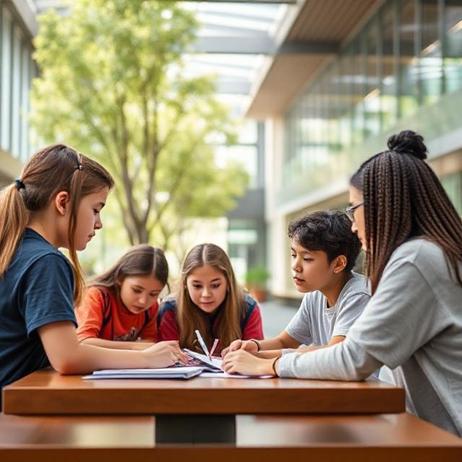The A to Z of Private Schools in 2025
In the evolving landscape of K–12 education, the decision to enrol a child in a private school remains one of the most significant choices a family will make. This A to Z guide offers parents, students and educators a comprehensive overview of private schools in 2025 — from Admissions and Tuition to Values, Workforce and Zoning considerations. The structure mirrors the classic A–Z format while reflecting the latest data, policies and real-world insights for this year.
A – Admissions & Accreditation
Admissions into private schools today often involve more than submitting an application and transcript. Many schools incorporate assessments, interviews and even student-portfolio reviews. According to a recent guide, private schools may set higher graduation requirements and expect a culture of “learning is expected, not optional.” Private School Review Accreditation remains a key differentiator: families should look for regional or national accrediting bodies to ensure curriculum quality and smooth college transitions.
Internal link: For boarding and day distinctions, see our related overview at BoardingSchoolReview.com.
B – Boarding versus Day School
While the vast majority of private K-12 schools are day schools, boarding options continue to attract families seeking immersive residential experiences. According to analysis, full boarding school costs for seven-day boarding in 2025 are averaging around $69,150 per year. Day-school private tuition is significantly lower (see Section T). When choosing between boarding or day, families should weigh campus life, independence of students, travel logistics and community fit.
C – Choice & Scholarships
Private school choice programs, including vouchers, tax-credit scholarships and education savings accounts (ESAs), are increasingly influential. By the end of 2024, more than one million students in the U.S. were participating in a private school choice program. These policies are reshaping access and affordability. For example, states such as Florida and Arizona have reached double-digit percentages of K–12 students in choice programs. Families should investigate eligibility, scholarship caps and how much net cost remains after aid.
D – Demographics & Diversity
According to data from National Center for Education Statistics (NCES) and other studies, about 9 percent of U.S. K-12 students attend private schools (roughly 4.7 million) in the most recent federal snapshot. Meanwhile, Census-based analysis showed private-school share rising to about 11.8 percent by 2022.
Private schools are also becoming more diverse in geography and student composition, though size remains relatively small: the national average private-school enrollment is about 177 students in 2025.
E – Educational Model & Environment
One of the enduring appeals of private schools is their flexibility in curriculum, scheduling and campus culture. Many private schools emphasise small class sizes, individualised instruction and enriched offerings in arts, languages or STEM. As stated by one college-counselling director: “Private schools create an environment where learning is expected, not optional.” Families should ask about student-teacher ratios, the breadth of electives, digital integration and how the school defines student success beyond test scores.
F – Financial Aid & Fiscal Health
Sticker tuition is only part of the cost equation for private schools. Many institutions offer need-based aid, merit scholarships or sliding-scale tuition models. Recent reports show that independent schools have strengthened financial metrics in 2025 even amid slower growth. When evaluating a private school, ask for the percentage of students receiving aid, average grant amounts, and how tuition increases are managed year-to-year.
G – Governance & Accreditation Bodies
Private schools operate under governance models—independent boards, religious organisations or non-profit trusts. Accreditation bodies (regional or national) ensure that standards in curriculum, staff qualifications and governance are met. Accreditation lends credibility for college admission and can often be required by state scholarship eligibility.
H – Hybrid & Home-School Partnerships
In response to changing family preferences and evolving educational models, some private schools now offer hybrid programmes (in-school + online) or partner with home-school networks. While this remains niche, the trend signals greater flexibility in how private schools deliver instruction, especially for families seeking customized pathways.
I – International Students & Global Orientation
Though most private schools serve domestic student populations, many elite independent schools maintain significant international enrolments. These global students enrich campus diversity, enhance language offerings and prepare all students for a globalised world. Families should check visa support, ESL resources and global study opportunities if international orientation matters.
J – Justification & Value Proposition
Why choose private school in 2025? Families often point to smaller classes, tailored instruction, college-preparatory rigor and extra-curricular breadth. One institutional blog notes that parental involvement, specialised programs and a culture of high expectations are distinctive advantages.While value is subjective, parents should weigh return on investment: academic outcomes, graduate trajectories and fit.
K – Kindergarten Entry & Early Years
Many private schools accept students at the Pre-K or Kindergarten level, offering early childhood programmes with lower student-teacher ratios and enriched preparatory work. For families planning long-term, early entry can build continuity through primary and secondary years. Admission may begin early and waiting lists are common for popular schools.
L – Location & Local Market Dynamics
Private school access and affordability vary significantly by region. For example, the Northeast houses the highest proportion of private-school enrolment share (~13 percent) while the West is lower (about 8.3 percent) according to 2021 data. Within urban, suburban and rural markets, private school presence also varies: a Learning Policy Institute report found about 83 percent of private schools are in urban or suburban areas, leaving 17 percent in more remote regions. Learning Policy Institute Families relocating or exploring markets should review local competition, commute, and demographic fit.
M – Mean Tuition & Market Pricing
Tuition is a key metric. According to PrivateSchoolReview, the national average private school tuition for 2025–26 is $14,999/year (elementary average ~$14,018; high school average ~$17,954) across day institutions.That said, among independent school day programmes, median tuition has reached record highs — for example, one S&P Global analysis placed day-school median at $49,284. Families must distinguish between broad private-school averages and high-end independent school pricing.
N – Non-Profit vs. For-Profit Status
The majority of private K–12 schools are non-profit independent or religiously affiliated institutions. For-profit private schools are a smaller segment and may follow different tuition, governance and outcome structures. Families should check mission statements, board transparency and accreditation irrespective of profit status.
O – Outcomes & Post-Secondary Prep
One of the traditional selling points of private schools is strong college-preparatory outcomes, smaller classes and enhanced advising. In 2025, schools emphasize metrics such as AP participation, dual-credit opportunities, mentorship and career readiness. Internal link: For boarding vs. day comparisons and outcome metrics, visit BoardingSchoolReview.
P – Programs & Pedagogy
In 2025, private schools are embracing specialized programs: global studies, STEM, arts integration, social-emotional learning, and personalized learning pathways. According to Forbes, new private schools are being designed around different models of pedagogy including cost models, technology integration and customised scheduling. Families should ask about signature programmes, technology-enhanced learning, and special-education support when applicable.
Q – Quality Assurance & Continuous Improvement
Reputable private schools engage in ongoing self-study, external review, staff professional development and alignment with best practices. Parents are wise to review school accreditation reports, faculty credentials, turnover rates and strategic plans to assess institutional quality.
R – Retention & Recruitment Trends
In 2025 private schools continue to navigate enrollment dynamics post-pandemic. According to a recent survey by the Cato Institute, about 40 percent of private schools reported increased enrolment between the 2023–24 and 2024–25 school years; 32 percent saw decreases and 28 percent no change. Schools attribute growth to values-alignment (69 percent), academic experience (44 percent) and parental religious beliefs (43 percent). Families should ask about wait-lists, retention rates and how the school adapts to demographic shifts.
S – Student Experience & Safety
Private schools frequently emphasise holistic development: rigorous academics, robust co-curricular offerings, and close supervision. Studies show that parental involvement and smaller classes support better outcomes. Safety protocols, campus culture and wellbeing programmes are also increasingly important considerations for families.
T – Tuition Trends & Transparency
Tuition increases have been a point of concern. Inflation, staffing costs and facility upgrades are cited as drivers of rising tuition. A Bloomberg report in early 2025 noted day-school tuition at certain independent schools had climbed above $49,000. Transparency of total cost—including fees, enrichment, travel and boarding—is key. Families should ask for typical tuition increase rates over the past three years, average net cost after aid and schedule of extra fees.
U – Unique School Types & Unconventional Models
The private-school sector is evolving. New models include micro-schools, hybrid formats, faith-based schools, and tech-driven private schools. For instance, new “AI-driven” private schools are emerging (e.g., the Alpha Schools venture) that prioritise adaptive learning and spend less time on traditional classroom lectures. Such options may appeal to families seeking innovation, though they warrant careful evaluation regarding accreditation, outcomes and cost.
V – Values & Mission Fit
A critical element of private-school selection is ensuring alignment between the school’s mission, values and your child’s needs. Whether religious, secular independent, Montessori-inspired or STEM-focused, the best fit school will reflect your family’s educational priorities. The Cato survey mentioned above finds values alignment is the primary enrolment driver.
W – Workforce & Faculty
Experienced teachers, lower turnover and robust professional development often distinguish private schools. Many private schools report student-teacher ratios well below public-school averages and invest in faculty as the heart of the student experience. Families should ask about average class size, faculty credentials, and how the school supports new teachers.
X – eXtra-Curricular & Expansion
Beyond core academics, private schools typically offer a richer breadth of extracurriculars: global travel, arts and music conservatories, leadership programmes, sports and service. In 2025, many are also expanding campus facilities, launching new partnerships and enhancing digital learning infrastructure. Families should explore the breadth and depth of these programmes when comparing schools.
Y – Yearly Review & Yield Rates
When researching private schools, consider school yield (percentage of accepted students who enrol), retention rates, baseline year-to-year enrollment stability and alumni outcomes. These metrics give insight into school reputation, fit and stability. Schools with high first-year attrition may signal concerns about matching students to the culture.
Z – Zoning, Zone-of-Choice & Local Market
Although private schools are not bound by residential zoning in the same way public schools are, local market dynamics matter. Proximity, commute time, sibling scheduling, transportation and regional tuition differences all play a role. In some regions private school choice programmes alter the zone of finances and access. Families should understand how their local private school market behaves, including scholarship competition, bus routes and sibling policies.
Conclusion
Choosing a private school in 2025 involves much more than cost and prestige. With evolving enrolment trends, tuition pressures, choice programmes and innovative models, families must engage deeply with school fit, values alignment and long-term outcomes. This A to Z guide equips you with the vocabulary and questions needed to compare options thoughtfully. For deeper boarding-versus-day analysis and profiles of specific private schools, visit BoardingSchoolReview.com.
As one admissions expert recently advised: “It isn’t just about selecting a school — it’s about selecting the educational ecosystem that best supports this child’s growth.”












